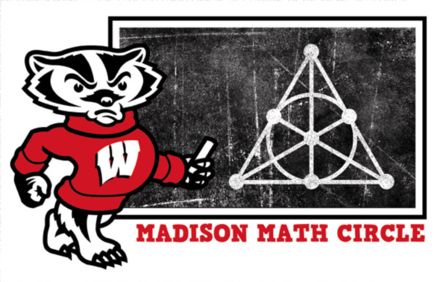Madison Math Circle Abstracts: Difference between revisions
Jump to navigation
Jump to search
No edit summary |
No edit summary |
||
| Line 269: | Line 269: | ||
= High School Meetings = | = High School Meetings = | ||
== | == Date TBD (High School TBD) == | ||
<center> | <center> | ||
{| style="color:black; font-size:100%" table border="2" cellpadding="10" width="700" cellspacing="20" | {| style="color:black; font-size:100%" table border="2" cellpadding="10" width="700" cellspacing="20" | ||
|- | |- | ||
| bgcolor="#e8b2b2" align="center" style="font-size:125%" | ''' | | bgcolor="#e8b2b2" align="center" style="font-size:125%" | '''Speaker TBD''' | ||
|- | |- | ||
| bgcolor="#BDBDBD" align="center" | '''Title: | | bgcolor="#BDBDBD" align="center" | '''Title: TBD''' | ||
|- | |- | ||
| bgcolor="#BDBDBD" | | | bgcolor="#BDBDBD" | | ||
Abstract TBD | |||
|} | |} | ||
</center> | </center> | ||
Revision as of 21:26, 25 August 2017
September 18 2017
| Speaker |
| Title: TBD |
|
Abstract |
September 25 2017
| Speaker |
| Title: TBD |
|
Abstract |
October 2 2017
| Speaker |
| Title: TBD |
|
Abstract |
October 9 2017
| Speaker |
| Title: TBD |
|
Abstract |
October 16 2017
| Speaker |
| Title: TBD |
|
Abstract |
October 23 2017
| Speaker |
| Title: TBD |
|
Abstract |
October 30 2017
| Speaker |
| Title: TBD |
|
Abstract |
November 6 2017
| Speaker |
| Title: TBD |
|
Abstract |
November 13 2017
| Speaker |
| Title: TBD |
|
Abstract |
November 20 2017
| Speaker |
| Title: TBD |
|
Abstract |
January 29 2018
| Speaker |
| Title: TBD |
|
Abstract |
February 5 2018
| Speaker |
| Title: TBD |
|
Abstract |
February 12 2018
| Speaker |
| Title: TBD |
|
Abstract |
February 19 2018
| Speaker |
| Title: TBD |
|
Abstract |
February 26 2018
| Speaker |
| Title: TBD |
|
Abstract |
March 5 2018
| Speaker |
| Title: TBD |
|
Abstract |
March 12 2018
| Speaker |
| Title: TBD |
|
Abstract |
March 19 2018
| Speaker |
| Title: TBD |
|
Abstract |
April 2 2018
| Speaker |
| Title: TBD |
|
Abstract |
April 9 2018
| Speaker |
| Title: TBD |
|
Abstract |
High School Meetings
Date TBD (High School TBD)
| Speaker TBD |
| Title: TBD |
|
Abstract TBD |
